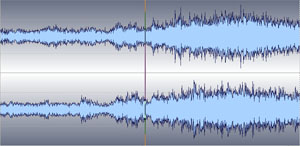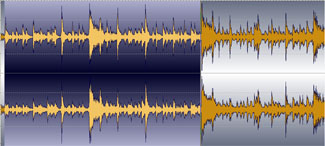| |
 |
|
Music for Rhythmic Gymnastics |
Rhythmic Gymnastics is about an expression, accompanied by music, through the use of body movement and light hand apparatus from the gymnast to the audience. Appropriate use of music draws the audiences emotion along with its movements. In the sport of rhythmic gymnastics, routines without music will not be judged.
|
|
How do you find the right music? |
|
Finding the right music is half the battle. Some countries have musicians that make up the music to the routine. However, this is not common in North America. Most people tend to splice from movie soundtacks or instrumental pieces.
- What apparatus is the music for? - As an example, rope tend to be fast and ball music tends to be sromantic and softer. Clubs music are usually spirited and/or playful. Each coach may have their own preference.
- Are there enough variations to support change of pace and rhythm?
- Where are the big notes?
- What is the age of the gymnast? Is it appropriate for his/her age? Can the gymnast's movement match with the speed and intensity of the music?
- Is there a section that characterize the entire piece?
- Will the music sound OK in ordinary sound systems?
- Will the coach / gymnast get tired of it easily?
- Does the gymnast like it?
- Does the music inspire movements / dance steps?
- Avoid music that is great the first time but gets onto your nerve after a while. Remember that both the coach and the gymnast have to listen to it A LOT times over the season.
- Avoid music that takes time to grow on you. During competitions, you only have minute and a half to create an impression for the judges and audiences.
- Avoid music that are classics by specific gymnasts or those by your current champion. As an example, I probably will avoid using "Bolero", "love Story" or "River Dance" if I am doing skating.
- Borrow music ideas from others - You can always splice your own after you locate the title / composer / artist.. Some great music lists are as follows:
|
Music Editing |
|
In the old days, music editing at home means that you are playing your music source from one end and recording it over a tape casseette. You will need good ears and a quick reflex to cleanly splice music this way.
The most basic music editing software will give you the ability to visually edit your music. You can copy and paste to repeat chorus and sometimes even down to a note. The following list some of the slightly more advanced features that can come in useful.
  
If this is your first time editing music, pick something that has clear distinct notes instead of something like violin or orchestra will help build confidence. As you can see above, the one on the right have clear graphical notation of each note or phrase, making it much easier to select and cut.
- Markers / labels - Being able to mark the music so that you can fine tune the selection or go to it quickly can be a great time saver.
- Fade in / out - Abrupt ending of the music can be soften by using the fade out feature. The same applies for fade in where a harsh start of the music can be avoided.
- Change gain - Some soft music may play great at home in an ideal setting. In gymnastics where the performances are in big halls using less than ideal equipment, you may need to boost up (or tone down) the volume for some sections of the music.
- Mix - This is a special way of allowing connecting of different instruments by overlapping them nicely (versus an abrupt change). Using the 'MIX' operation, one instrument can start to fade out when the next instrument is being introduced - making the 'JOIN' seamless. Some programs accomplish this via a special PASTE operation, the higher end software use multi-track mixing to accomplish this.
- Time stretch - There are times when you simply want to extend the music by a second or two without adding a whole phrase of music to it. This features allows you to do so without changing the pitch of the music.
- Ripping from a CD - this can be done using a 3rd party software. Having this feature inside the music editing softare is simply for convenience.
|
Music editing software |
Free
Consumer
Professional
|
Ripping or format conversion software |
|
Some music editing software may already have facility to source the music off a CD or mp3 download. However, occasionally you may need to rip or convert your source into something that your music program can understand.
|
Code of point considerations |
|
Some music editing software may already have facility to source the music off a CD or mp3 download. However, occasionally you may need to rip or convert your source into something that your music program can understand.
- Background music - choreography with no relevancy to the characteristics of the music is considered as background music and subject to deductions. Furthermore, a potpourri of disjointed music without a cohesive theme 0 is not allowed.
- Length of music - the timing starts when the start moving and stops when the music stops. The length of allowable music depends whether the music is intended for individuals or groups, FIG versus domestic developmental levels. Music introduction of 8 counts are allowed. So a piece of music can be longer than the legal time limit but the routine must be within the time limit or else there is a music deduction.
- Inappropriate noises such as engine noises, police sirens, breaking of objects are not allowed.
- The CD must be labelled properly including name, country code, apparatus symbol, length, title, composer / artist for the music. Each piece of music must be on its own CD and in the audio CD format (not MP3).
- Voice, used as an instrument (i.e. without words), are allowed.
|
Frequently asked questions |
|
- How can I remove vocals from a song? - You cannot really isolate the vocals from the music perfectly. Some says that vocals are within the mid-range of the sound spectrum and therefore can be isolated, however, not only do you require professional software and skill, you will lose parts of the musical instruments at the same time.
- What comes first? music or the routine? - In movies, the sound effects and music scores are created after the movie is filmed and edited. Some choreographers do the same thing, they create the dance / routine first and then have a musician create the music specifically for the piece. However, because of the cost involved, the process in North America is usually the reverse, you select and edit the music first and then choreograph to the music. If you are not a musician but want to create your own music, SONY's ACID PRO and CINESCORE may give you what you want.
- Does it cost any money for edited music? - It involves a lot of time searching for the music and then editing it to perfection. If a gymnast is paying for the music, chances are that it is a payment to cover the time for the music editing and search, and not as a royalty to the record company or musician. Check out the copyright rules before you 'sell' any routine music.
- I no longer use last year's music, can I sell it? - Each club's arrangement may be different, you should always check your initial agreement. If you have exclusive use of the music, chances are that you can 'sell / pass' the music on to your teammates. However, you may have paid a lower fee with the explicit condition that the music belongs to the club / coach and you cannot transfer / resell to another gymnast. So ask explicitly as to what you are allowed to do in all cases.
|
Trivia |
|
Even as of the first Olympics for rhythmic gymnastics in 1984, music for routines are played by real musicians at the competition. During this period, music is limited to only 1-2 instruments. When you think about it, travelling to international competitions means double the cost. In 1994, orchestral multi-instrument music and pre-recorded music were allowed in routines. in 2001, CD was allowed in offical FIG competition. In 2004, the code is changed to allow vocals (without words). In 2013, a gymnast is allowed 1 routine with vocals with words.
|
|
|
|


